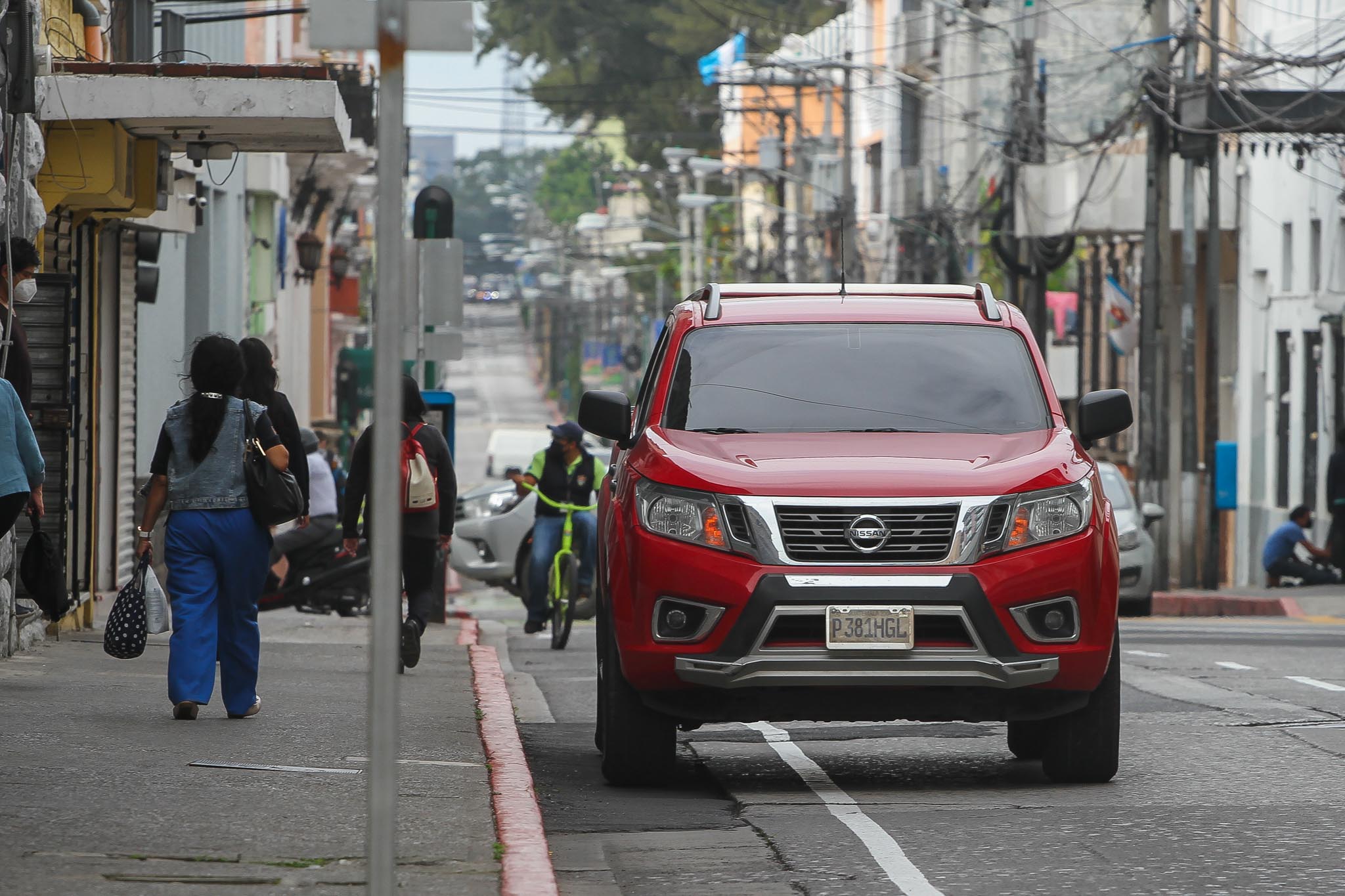Mobility in Guatemala, a dystopian and dysfunctional reality.
- Scarce citizen culture in organization and public space claim, with little urban planning by local authorities, contribute to the prioritization of motor vehicle use in the Central American country.
- State bureaucracy and low citizen participation in the design and application of solutions, explain the little success and functionality of the existing initiatives.
“I love riding a bike and I wouldn’t change for a car, the traffic and for nothing in the world. The time I make to my work is 15 minutes. When I went by bus, I would make an hour and a half,” tells Josselyn Pinto, an art curator that travels roughly 7 kilometers (4.3 miles) a day from her home to her place of work. Like her, Norma Citalán, a psychologist and cyclist athlete, tells that, even though she uses her bike more in sports competitions, she has used it as transportation as well, but with caution, “because motorists and drivers are very imprudent. They will throw their motorcycle, their will throw their cars at you. It’s dangerous,” she confess.
Guatemala City is the largest one of all Central America. It is estimated that its population is double than the closest cities, Tegucigalpa in Honduras and Managua in Nicaragua. And not just that, but out of the 10 most populated municipalities in the isthmus, three are Guatemalan. The population density and the vehicle fleet has taken these municipalities to create specific spaces of mobility, such as bike lanes, without achieving the objective of incentivizing the use of the bicycle over cars. “They are very badly designed” Joss complaints.
Regarding the reasons on why the design of Guatemalan cities, and their solutions for mobility don’t work, (poor urban planning, social insecurity) a lot has been written and talked about. But very little has been discussed about the real reason for all of this: there isn’t a culture to enjoy the street. True, Guatemalan urban citizens have abundant reasons to not enjoy their streets: unsafely and insecurity, poor road education, pollution; but this lack of culture is evident from the people whose responsibility is to plan and handle the public spaces. The use of automotive vehicles is prioritized about any other means of mobilization, and that reflects on the people’s attitude.
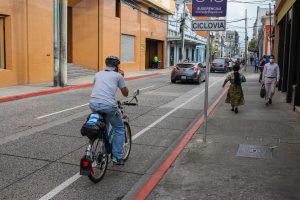
A cyclist moves along the bike path located at 7a. avenue of the Historic Center in Guatemala City.
Anybody that walks on any part of Guatemala, regardless of being in the city or any other urban center of the country, will know that for example, pedestrian crossings and paths are mere ornaments. Is as if for who mobilizes in a car, the pedestrians don’t exist. There is a lot of hurry to get everywhere and nowhere. Nobody gives way, double rows are made where they should not, public transport units such as buses are overloaded, motorcycles move in between lanes and over sidewalks, and sometimes even against the way.
To all of this you have to add that the design in exclusive lanes, shopping malls, parking lots and housing complexes always prioritize vehicular access over pedestrian. “The design of Guatemala City goes against its own development, since not having safe mobility alternatives, the psychological and social health of its inhabitants its affected due to stress”, states sociologist Ana Silvia Monzón.
Half Solutions
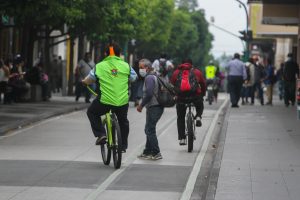
A cyclist must evade a pedestrian who is walking on the Sixth Avenue bikeway, in the Historic Center of Guatemala City. Scenes like this are seen at all times, due to the little education about mobility in the country.
It is estimated that in 2019, Guatemalan city inhabitants wasted about 828 million hours in traffic, which is equivalent to a third ($4 million) of the Nation’s general budget. Even though there are about 10 bicycle lanes functioning, these aren’t solving the situation in an effective way. “These are dangerous because they are not signaled properly”, Joss tells and also adds that having to share them with pedestrians, and the little respect that drivers and motorists have towards use bicycles, makes them less reliable routes.
This opinion contradicts with the vision that the municipality assures they want to implement. This affirmation comes from that, based in a graphic reference known as the “Pyramid of Road Mobility”, pedestrians and non-motorized vehicles are the ones that have the priority when mobilizing in the streets and avenues of the country. Amilcar Montejo, road spokesman of the Municipality of Guatemala, says that there are information campaigns in social networks and media, to raise awareness among citizens about the Traffic Regulations. “Fines are imposed on those who do not respect the exclusive spaces”, he assures. The complaint of bicycle users is that the authorities act reactively, since drivers are only sanctioned with fines after disrespecting spaces and means of transport.
Norma goes even further and asks for a “specific law for the protection of cyclists”, since the current ruling is “too general and I believe that it doesn’t work for us, there is a lot of people that has died due to the negligence of drivers and motorists”. Besides the necessary infrastructure it is very important that, according to the athlete, bike users have a legal backup since “the death of cyclists always goes unpunished” she reassures. In the first four months of 2020, the National Institute of Forensic Sciences reported 792 deaths in road incidents. 38% of the deceased where pedestrians.
Henry Castañeda, Chief of the Urban Mobility and Transportation Office of the Municipality of Mixco, one of the 16 municipalities of the department of Guatemala, decided to create spaces to find efficient solutions. “When I got out of work and watched that a cyclist was coming on my way, I would drive my car up to them and tell them: Look, I’m doing mobility workshops and you should come and participate”, he tells. This savage method, besides provoking the logical irritation of whoever crosses in his path, also allowed him to contact in people interested in being part of the solution. “I’d have to explain my intentions and that I needed their participation, to design the lanes (exclusive) to that cyclist so he could use his bike as a conveyance”, he explains.
To this date he has held three workshops where the concept of a Network of Bicycles Paths emerged, and that it would be comprised of 83.15 kilometers (51.96 miles) of segregated of bike paths, 176.05 kilometers (110.03 miles) of priority bike paths, and 150.75 kilometers (94.21 miles) of shared bike paths, that would cover about 90% of the Municipality’s territory.
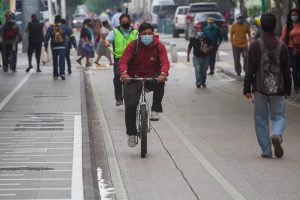
A motorist rides on the bike lane of the 7th. avenue of the Historic Center of Guatemala City.
Henry is also part of a collective called “The New Mobility”, that promotes the use of bicycles as a conveyance and the creation of bike paths. It was in this space, and with the arrival of the COVID-19 Pandemic, that Alejandro García Rodríguez, an architect and independent development consultant, took advantage to conceive a proposal, that he later presented in his social media, of transforming the existing ways and lanes to adapt to exclusive use for bicycles and other non-motorized vehicles. “What we want is to change the urban mobility paradigm”, explains.
Part of the strategy is to habilitate an exclusive lane in large driveways such as the Roosevelt (the main exit and entry way of the city to the west) to implement a bike path, or take the lane of the Transmetro (a public transportation system that functions on exclusive lanes) and habilitate it as a huge temporary way for bicycles.
To achieve this according to Alejandro, it doesn’t take a huge investment on the part of the communes and would be a rapid implementation alternative, that would help reduce the transfer times, traffic jams and environmental pollution, and give safe routes for mobilization of the population, to not depend on public transportation.
At the beginning of August, the city’s municipality created two exclusive bicycle lanes of 1.75 miles (2.8 kms) long, that run through two main avenues in the Historic Center of the city. With little socialization and an inefficient road education, the launch of this space evidenced the struggle that exists between motorists and other people for the hegemony of the road space.
For the city to be friendly with the people that live in it. “a lot of conditions are required: that there are political changes in the conduct of city management, and that an urban agenda is agreed with the inhabitants, as well as that quality of life is prioritized in urban planning, and that budgets are destined for that as well” Monzón explains.
Between yearnings and frustrations
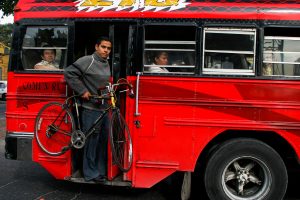
A bicycle user must move on a bus of the Urban Passenger Transport System, after suffering a flat tire. The lack of exclusive routes for cyclists, as well as workshops for them, make scenes like this recurrent.
“If more people gathered, this proposals would achieve more success”, expressed Henry when asked about how Guatemala could do something similar as Holland. With the arrival of the pandemic and restrictions in transportation implemented by the government, the female group of cyclists, SheCycles Guatemala, organized an online petition in which they requested authorities to habilitate the Transmetro lanes to be used by cyclists, as well as education, learning and capacitation spaces for cyclists to use proper clothing and that they also respect the traffic signs as any vehicle, circulate with the right of way and respect for pedestrians. To this day, the petition has surpassed the 3 thousand online signatures for people that wish to use the bicycle to mobilize themselves in these lanes.
This, plus Alejandro’s proposition add to the citizen’s interest to generate a change that doesn’t quite settles. While politics and bureaucracy get to an agreement, bicycle users like Joss can only limit themselves to yearn on counting with dignified and safe spaces, and for a local urban interconnected system, “so we can be able to travel and move around the city”.
Castañeda on his part, insists on the union of people to be key to achieve these goals. “The problem is that the organized proposals cost a lot to be given, and specially if they have technical support. I consider that if the new mobility is joined by a lot more citizenry, the proposals should be generated alone” he explains. And this is the collective vision that will help the achievement of these goals. Its not contemplated that 100% of the population migrates from motor vehicles to bicycles, but the awareness that the mobility of a functional city must consider other means is installed, besides from automobiles. “In the end, mobility must be in several modalities for it to be effective”, finalizes García Rodríguez.
